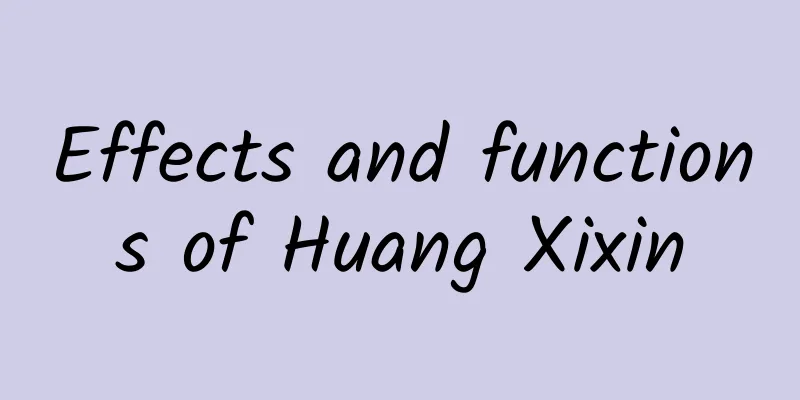The efficacy and function of shady fern

|
As people's living standards continue to improve, health and longevity are gradually valued by us, so nowadays health-preserving diet therapy methods are very popular, the trend of traditional Chinese medicine is becoming more and more popular, and Chinese medicine has once again occupied people's vision. Today we will talk about the Chinese medicine Yindi fern. [Other names] A cloud (Tianbao Materia Medica), flower fern (Botanical Dictionary), independent golden rooster (Guizhou Folk Prescriptions Collection), single-legged wormwood, winter grass (Compilation of Common Folk Herbs), Langqi Asarum (Guiyang Folk Herbs), back snake (Sichuan Chinese Materia Medica), broken sky cloud, scattered blood leaves (Hunan Materia Medica), small spring flower, snake does not see, hanging bamboo good branches, good branches grass (Mindong Materia Medica), single-legged golden rooster, Dangui Yixingcao (Zhejiang Folk Herbs). [Source] It is the whole herb with roots of the Pteris shadyii plant of the Pteridaceae family. Harvest in winter or spring, dig up with roots, wash and dry. [Original form] Perennial herb, more than 20 cm tall. The rhizome is thick and fleshy, with many fibrous fleshy roots. The petiole of the nutrient leaf is 3 to 8 cm long, the leaf blade is triangular, 8 to 10 cm long, 10 to 12 cm wide, and pinnate-shaped three times. The lower pinna is the largest, with a long petiole and a long triangle. The upper pinnae are gradually sessile, lanceolate, and the lobes are oblong to ovate, 0.3 to 0.5 cm wide, with fine serrations, and the leaf surface is glabrous and thick. The sporophylls have long stalks, 12 to 22 cm long; the spores are gathered in cones in the spikelets, 5 to 10 cm long, with 3 to 4 pinnate branches; the sporangia are sessile, yellow, arranged in two rows along the inner side of the spikelet, not sunken, and transversely split. [Habitat distribution] It grows in the shade and wet places of grassy slopes and shrubs in mountainous areas. Distributed in Hubei, Hunan, Jiangxi, Anhui, Zhejiang, Taiwan, Fujian, Guizhou, Sichuan, Guangxi and other places. It is produced in Sichuan, Zhejiang, Fujian, Hunan, Guizhou and other places. [Properties] The whole plant is dried, with thick and fleshy rhizomes that are gray-brown or brown in color. The petiole is cherry red with longitudinal stripes, and the nutrient petiole is thinner and shorter than the spore petiole. The leaves are triangular and 3-pinnate. The sporangium spikes are cone-shaped and the sporangium is brown. Slight odor, light taste. 【Nature and flavor】 Sweet, bitter, cool. 【Functions and indications】Calming the liver, clearing away heat and relieving cough. It is used to treat dizziness, headache, coughing up blood, epilepsy, conjunctivitis, eye opacity, sores and swelling. [Usage and Dosage] For oral use: decocted in water, 2-4 qian (0.5-1 liang for fresh ones). For external use: mash and apply. [Additional prescription] ① Treating hot cough: 2 to 5 cents of a cloud, add white radish and rock sugar. Take it in decoction. (If there is no white radish, you can just boil water with rock sugar and drink it) [Clinical Application] The medicine "Xiao'erxi" made from yindi ferns is injected intramuscularly once a day, 1 to 2 ml each time, to treat upper respiratory tract infection, pharyngitis, tonsillitis, mumps, mandibular lymphadenitis, etc. in children. It has anti-inflammatory and antipyretic effects. Most patients will have subsided fever within 1 to 4 days. A few people may experience vomiting, mental weakness, etc. after taking the medicine. 【Excerpt】 《*Dictionary》 [Source] From "Compendium of Materia Medica": Shade fern grows in the valleys of Neixiang, Shunyang County, Dengzhou. The leaves are similar to Artemisia annua, the stems are purple-green, the flowers are spikelets, slightly yellow, and the roots are similar to Asarum. The roots and seedlings are collected in July. In the above article, we analyzed the yindi fern and knew that the effects and functions of the yindi fern are very wide-ranging. As long as we know more about the medicinal properties of traditional Chinese medicine, we will not panic when encountering diseases. |
<<: Effects and functions of silver poplar leaves
>>: The efficacy and function of Pterocephalus
Recommend
If you can't find a job after graduation, you are a failure? These 5 "dangerous misunderstandings" are quietly destroying young people's mental health
May 25th of each year is the National College Stu...
The efficacy and function of tea oil
There are many kinds of common Chinese medicinal ...
The efficacy and function of chrysanthemum leaf Panax notoginseng
Traditional Chinese medicine is a Chinese traditi...
Whispering under the stars: Uncovering a corner of the mystery of the universe
In the vast universe, the Earth we live on is jus...
The Hotan-Ruoqiang Railway officially opens to traffic today, encircling the Taklimakan Desert
June 16 Hotan-Ruoqiang Railway (hereinafter refer...
What are the effects of snow lotus tea?
As a plant, snow lotus has very unique medicinal ...
Biohazard in the rainforest! The terrifying poison dart frog is really poisonous...
(Image from copyright gallery) Deep in the dense ...
The efficacy and function of water lily leaves
As a traditional Chinese medicine, water spinach ...
The efficacy and function of fireweed root
We can often see the roots of big fireweed in our...
International Day of Persons with Disabilities | We may be different, but we can all…
Producer: Chen Kaixing, Zou Shengwen Producer: Yu...
Resembling the Big Dipper! This is the most flaming volcano in the Yitong volcano group!
It turns out that this is the most fiery volcano ...
One bite of "overnight watermelon" contains 8,400 bacteria? Can you still eat it? The key is to look at these points
Experts of this article: Ruan Guangfeng, Director...
What are the medicinal effects of Ma Shicai?
Ma Shicai is a very common wild vegetable and is ...
Young man digging graves and stealing corpses at midnight: I am here to bury Caesar |
Modern historiography seems to have become a conv...
Will drinking too much saffron cause internal heat?
Rose tea is sweet and warm in nature. It is a neu...









